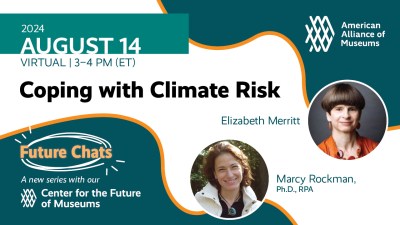
My journey into the museum field was a winding road. Graphic design led to marketing and branding. I later transitioned to art education and learned the slings, arrows, and overwhelming payoff of the public school sector. My current profession—museum education—is a wonderful amalgamation of these careers. I currently work at the Ruth and Elmer Wellin Museum of Art, a four-year-old museum on the 200-year-old campus of Hamilton College in Central New York. The surrounding school districts are both rural and urban, with a socioeconomic range from financially strained to affluent. We are a young museum, seeking to build a constituency and dispel the “ivory tower” persona that is so often attached to museums and higher education institutions more generally.
For the past year I’ve been conducting a study, funded by an Andrew W. Mellon Foundation grant, on what makes public school teachers choose to use a museum as part of their curriculum. This topic is very important to me as a museum educator because if we know what potential “clients” (a.k.a. teachers) want, we can better suit our “product” to meet their needs. The best way to determine what teachers want and need is to simply ask them. So I do—constantly.

ART TEACHERS FROM REGION 3 NYSATA MAKING OBSERVATIONAL OIL PASTEL “ETCHINGS” OF
GREEK VESSELS FROM THE WELLIN MUSEUM’S PERMANENT COLLECTION.
As part of the research, I’ve had the pleasure of interviewing educators from other academic museums in the region. In general, they report the need to be more prepared to travel, the need for increased vigilance in outreach, and the need to be willing to meet teachers where they are in the classroom curriculum. As museum educators, we are a bridge between worlds. We need steady feet on the ground when it comes to pedagogy, and we need knowledge of museum offerings and also the Common Core curriculum. We also have to be creative and flexible in our thinking, able to repeatedly adapt to the needs of our audience, which are great. But how do we provide what teachers need?
I believe that part of the answer lies in simply changing the way we speak about museum-school collaborations. You may have heard the maxim of the legendary salesman Elmer Wheeler: “Don’t sell the steak, sell the sizzle.” I suggest that this is highly advisable for museums. Why? Because museums are chock-full of juicy “steaks” that can meet the reported needs of K–12 teachers and administrators, but we aren’t speaking their language, and this prevents us from getting them in the door. We are screaming, “Steak, steak! So tasty! So unique!” What we need to sell instead is the sizzle—how our art can fit into their curriculum.

SIXTH GRADERS FROM ER HUGHES ELEMENTARY SCHOOL IN NEW HARTFORD, NY BRING SHABTIS FROM THE WELLIN MUSEUM’S PERMANENT COLLECTION TO LIFE USING STOP MOTION ANIMATION.
A whole new world opens up when we turn our focus from speaking about the art itself using museum-industry terminology and speak instead on the benefits of the art, using the same vernacular spoken in schools. We need to learn their language, and meet them where they are in their curriculum.
For example, “We invite you to visit our new exhibition of Greek vessels” becomes “Our new exhibition of Greek vessels fits perfectly with Grade 2 ELA Domain 3 about ancient Greek civilizations.” Similarly, “close reads,” “primary documents,” and even “visual literacy”—all Common Core buzzwords—are things museums have always offered, albeit by different names. Museums are full of “primary documents”—they cover the walls and fill art storage. The skills associated with “close reading” are perfectly exemplified through Visual Thinking Strategies. VTS is also ideal for building “visual literacy” skills, as are most of the activities associated with looking at, speaking about, and making art.
To quote former U.S. Secretary of Education William Bennett, “The arts are an essential element of education, just like reading, writing, and arithmetic… Music, dance, painting, and theater are all keys that unlock profound human understanding and accomplishment.” As museum educators, we need to embrace the terms that teachers use in their modules and evaluations. Underneath the new verbiage is the fact that looking at, thinking about, and discussing art can be a fluid, effortless accent to the daily demands of today’s education systems.

AMBER GEARY SPADEA
Biography: Amber Geary Spadea is the Andrew W. Mellon Educator for School and Community Programs at the Ruth and Elmer Wellin Museum of Art at Hamilton College. Joining the museum in 2013, Amber created and presently manages the K-12 and community education programs, while concurrently conducting research through a two-year research grant funded by the Andrew. W. Mellon Foundation. With a background in both marketing and art education, Amber believes that art benefits the study of every subject, at every level of learning. She holds a BFA from Cazenovia College and a M.S. in Art Education from Syracuse University.
Ruth and Elmer Wellin Museum of Art at Hamilton College
198 College Hill Road Clinton, NY 13323
See more of the Wellin Museum on their website, Facebook, Twitter and YouTube.









Comments